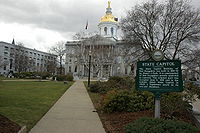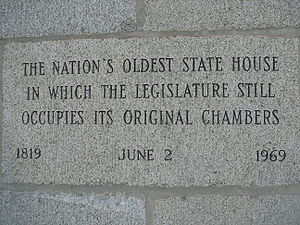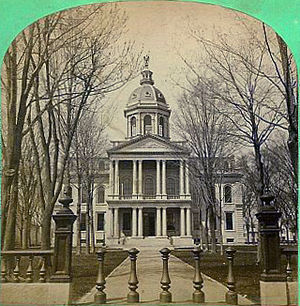
New Hampshire State House
Encyclopedia



New Hampshire
New Hampshire is a state in the New England region of the northeastern United States of America. The state was named after the southern English county of Hampshire. It is bordered by Massachusetts to the south, Vermont to the west, Maine and the Atlantic Ocean to the east, and the Canadian...
, located in Concord
Concord, New Hampshire
The city of Concord is the capital of the state of New Hampshire in the United States. It is also the county seat of Merrimack County. As of the 2010 census, its population was 42,695....
at 107 North Main Street. The capitol houses the New Hampshire General Court
New Hampshire General Court
The General Court of New Hampshire is the bicameral state legislature of the U.S. state of New Hampshire. The lower house is the New Hampshire House of Representatives with 400 members. The upper house is the New Hampshire Senate with 24 members...
, Governor
Governor of New Hampshire
The Governor of the State of New Hampshire is the supreme executive magistrate of the U.S. state of New Hampshire.The governor is elected at the biennial state general election in November of even-numbered years. New Hampshire is one of only two states, along with bordering Vermont, to hold...
and Executive Council
Executive Council of New Hampshire
The Executive Council of the State of New Hampshire is the executive body of the U.S. state of New Hampshire. The Executive Council advises the Governor on all matters and provides a check on the governor's power. New Hampshire is one of the few states that has an Executive Council, and is the...
. The building was constructed on a block framed by Park Street (named in honor of the architect, Stuart James Park) to the north, Main Street to the east, Capitol Street to the south, and North State Street to the west.
Construction
The current statehouse was designed in 1814 with the cost paid by the City of ConcordConcord, New Hampshire
The city of Concord is the capital of the state of New Hampshire in the United States. It is also the county seat of Merrimack County. As of the 2010 census, its population was 42,695....
. The building was built in 1816–1819 by architect Stuart Park.
The building was built in the Greek Revival
Greek Revival architecture
The Greek Revival was an architectural movement of the late 18th and early 19th centuries, predominantly in Northern Europe and the United States. A product of Hellenism, it may be looked upon as the last phase in the development of Neoclassical architecture...
style
Architectural style
Architectural styles classify architecture in terms of the use of form, techniques, materials, time period, region and other stylistic influences. It overlaps with, and emerges from the study of the evolution and history of architecture...
with smooth granite blocks. The entrance is covered by a small projecting portico
Portico
A portico is a porch leading to the entrance of a building, or extended as a colonnade, with a roof structure over a walkway, supported by columns or enclosed by walls...
supported by Doric columns. The balcony above is lined with a balustrade separated by Corinthian columns supporting a pediment
Pediment
A pediment is a classical architectural element consisting of the triangular section found above the horizontal structure , typically supported by columns. The gable end of the pediment is surrounded by the cornice moulding...
. Another balustrade lines the edge of the flat roof.
The windows on the first floor are rectangular in shape, the second floor are arched and the third floor are square panels. An octagonal drum with large arched windows supports a golden dome with bull's-eye windows and supporting a small lantern. A statue of a huge gold-painted wooden war eagle
Eagle
Eagles are members of the bird family Accipitridae, and belong to several genera which are not necessarily closely related to each other. Most of the more than 60 species occur in Eurasia and Africa. Outside this area, just two species can be found in the United States and Canada, nine more in...
looking to the left was raised in 1818. In 1957, it was replaced with an element-proof peace eagle statue looking to the right, with the original eagle given to the New Hampshire Historical Society
New Hampshire Historical Society
The New Hampshire Historical Society was founded in 1823. Its mission is to educate a diverse public about the significance of New Hampshire's past and its relationship to our lives today.-Introduction:...
.
The grounds
The capitol grounds occupy 2.6 acres (10,521.8 m²) and are enclosed by a granite fence. No gate impedes the flow of visitors, as this is "the people's house". Several statues are in the yard, including statues of Daniel WebsterDaniel Webster
Daniel Webster was a leading American statesman and senator from Massachusetts during the period leading up to the Civil War. He first rose to regional prominence through his defense of New England shipping interests...
, General
General
A general officer is an officer of high military rank, usually in the army, and in some nations, the air force. The term is widely used by many nations of the world, and when a country uses a different term, there is an equivalent title given....
John Stark
John Stark
John Stark was a New Hampshire native who served as a major general in the Continental Army during the American Revolution. He became widely known as the "Hero of Bennington" for his exemplary service at the Battle of Bennington in 1777.-Early life:John Stark was born in Londonderry, New...
, John P. Hale
John P. Hale
John Parker Hale was an American politician and lawyer from New Hampshire. He served in the United States House of Representatives from 1843 to 1845 and in the United States Senate from 1847 to 1853 and again from 1855 to 1865. He was the first senator to make a stand against slavery...
, and Franklin Pierce
Franklin Pierce
Franklin Pierce was the 14th President of the United States and is the only President from New Hampshire. Pierce was a Democrat and a "doughface" who served in the U.S. House of Representatives and the Senate. Pierce took part in the Mexican-American War and became a brigadier general in the Army...
, the only President
President of the United States
The President of the United States of America is the head of state and head of government of the United States. The president leads the executive branch of the federal government and is the commander-in-chief of the United States Armed Forces....
from New Hampshire. On the State Street side of the building, a monument to George H. Perkins
George H. Perkins
Commodore George Hamilton Perkins was an officer in the United States Navy during the American Civil War.-Biography:...
by sculptor Daniel Chester French
Daniel Chester French
Daniel Chester French was an American sculptor. His best-known work is the sculpture of a seated Abraham Lincoln at the Lincoln Memorial in Washington, D.C.-Life and career:...
and architect Henry Bacon
Henry Bacon
Henry Bacon was an American Beaux-Arts architect who is best remembered for the Lincoln Memorial in Washington, D.C. , which was his final project.- Education and early career :...
was built on the grounds in 1902.
Doric Hall
The main entrance opens into the Doric Hall (renamed the Hall of Flags). The hall is designed after Charles BulfinchCharles Bulfinch
Charles Bulfinch was an early American architect, and has been regarded by many as the first native-born American to practice architecture as a profession....
's design for the Massachusetts State House
Massachusetts State House
The Massachusetts State House, also known as the Massachusetts Statehouse or the "New" State House, is the state capitol and house of government of the Commonwealth of Massachusetts. It is located in Boston in the neighborhood Beacon Hill...
. The halls features 107 battle flags for New Hampshire representing the Civil War
American Civil War
The American Civil War was a civil war fought in the United States of America. In response to the election of Abraham Lincoln as President of the United States, 11 southern slave states declared their secession from the United States and formed the Confederate States of America ; the other 25...
, Spanish-American War
Spanish-American War
The Spanish–American War was a conflict in 1898 between Spain and the United States, effectively the result of American intervention in the ongoing Cuban War of Independence...
, World War I
World War I
World War I , which was predominantly called the World War or the Great War from its occurrence until 1939, and the First World War or World War I thereafter, was a major war centred in Europe that began on 28 July 1914 and lasted until 11 November 1918...
, World War II
World War II
World War II, or the Second World War , was a global conflict lasting from 1939 to 1945, involving most of the world's nations—including all of the great powers—eventually forming two opposing military alliances: the Allies and the Axis...
, and the Vietnam War
Vietnam War
The Vietnam War was a Cold War-era military conflict that occurred in Vietnam, Laos, and Cambodia from 1 November 1955 to the fall of Saigon on 30 April 1975. This war followed the First Indochina War and was fought between North Vietnam, supported by its communist allies, and the government of...
.
Senate Chamber
The Senate Chamber is located in the northeast corner of the capitol. It houses the 24-member chamber.Large arched windows light the chamber. Behind the rostrum are large mural
Mural
A mural is any piece of artwork painted or applied directly on a wall, ceiling or other large permanent surface. A particularly distinguishing characteristic of mural painting is that the architectural elements of the given space are harmoniously incorporated into the picture.-History:Murals of...
s, arched like the windows, depicting events of the state's history
History of New Hampshire
New Hampshire is a state of the United States of America located in the New England region in the Northeast. New Hampshire was one of the Thirteen Colonies that revolted against British rule in the American Revolution.-Founding: 17th century–1775:...
. The mural to the left depicts the first commencement
Graduation
Graduation is the action of receiving or conferring an academic degree or the ceremony that is sometimes associated, where students become Graduates. Before the graduation, candidates are referred to as Graduands. The date of graduation is often called degree day. The graduation itself is also...
at Dartmouth College
Dartmouth College
Dartmouth College is a private, Ivy League university in Hanover, New Hampshire, United States. The institution comprises a liberal arts college, Dartmouth Medical School, Thayer School of Engineering, and the Tuck School of Business, as well as 19 graduate programs in the arts and sciences...
; the next, Daniel Webster
Daniel Webster
Daniel Webster was a leading American statesman and senator from Massachusetts during the period leading up to the Civil War. He first rose to regional prominence through his defense of New England shipping interests...
reading the United States Constitution
United States Constitution
The Constitution of the United States is the supreme law of the United States of America. It is the framework for the organization of the United States government and for the relationship of the federal government with the states, citizens, and all people within the United States.The first three...
; after that, Abbott Thayer teaching his art class; and the last, John Stark
John Stark
John Stark was a New Hampshire native who served as a major general in the Continental Army during the American Revolution. He became widely known as the "Hero of Bennington" for his exemplary service at the Battle of Bennington in 1777.-Early life:John Stark was born in Londonderry, New...
preparing for battle in the Revolution
American Revolutionary War
The American Revolutionary War , the American War of Independence, or simply the Revolutionary War, began as a war between the Kingdom of Great Britain and thirteen British colonies in North America, and ended in a global war between several European great powers.The war was the result of the...
. The murals were painted by Barry Faulkner in 1942.
Large curved tables surround the rostrum and are replicas of originals.
House Chamber
The House Chamber houses the largest state legislative body in the United StatesUnited States
The United States of America is a federal constitutional republic comprising fifty states and a federal district...
, with 400 members. Large arched windows line the walls. On the rostrum hang portraits of John P. Hale
John P. Hale
John Parker Hale was an American politician and lawyer from New Hampshire. He served in the United States House of Representatives from 1843 to 1845 and in the United States Senate from 1847 to 1853 and again from 1855 to 1865. He was the first senator to make a stand against slavery...
, Abraham Lincoln
Abraham Lincoln
Abraham Lincoln was the 16th President of the United States, serving from March 1861 until his assassination in April 1865. He successfully led his country through a great constitutional, military and moral crisis – the American Civil War – preserving the Union, while ending slavery, and...
, George Washington
George Washington
George Washington was the dominant military and political leader of the new United States of America from 1775 to 1799. He led the American victory over Great Britain in the American Revolutionary War as commander-in-chief of the Continental Army from 1775 to 1783, and presided over the writing of...
, Franklin Pierce
Franklin Pierce
Franklin Pierce was the 14th President of the United States and is the only President from New Hampshire. Pierce was a Democrat and a "doughface" who served in the U.S. House of Representatives and the Senate. Pierce took part in the Mexican-American War and became a brigadier general in the Army...
, and Daniel Webster
Daniel Webster
Daniel Webster was a leading American statesman and senator from Massachusetts during the period leading up to the Civil War. He first rose to regional prominence through his defense of New England shipping interests...
.
History
The first session of the General Court began in 1819. The State House is the oldest state capitol in which the legislature meets in its original chambers.In 1814, discussion began about building a suitable building for the state capitol. The General Court debated three locations: Concord, Hopkinton
Hopkinton, New Hampshire
Hopkinton is a town in Merrimack County, New Hampshire, United States. The population was 5,589 at the 2010 census. It consists of three villages: Hopkinton, West Hopkinton, and Contoocook...
, and Salisbury
Salisbury, New Hampshire
Salisbury is a town in Merrimack County, New Hampshire, USA. The population was 1,382 at the 2010 census.-History:While still part of Massachusetts, the town was granted as Baker's Town after Captain Thomas Baker in 1736. After New Hampshire became a separate colony, the town was re-granted by the...
, which offered $7,000 to be the capital. The legislature chose Concord as the location in 1816. Granite
Granite
Granite is a common and widely occurring type of intrusive, felsic, igneous rock. Granite usually has a medium- to coarse-grained texture. Occasionally some individual crystals are larger than the groundmass, in which case the texture is known as porphyritic. A granitic rock with a porphyritic...
used to build the capitol came from the present-day Swenson quarries; the cutting, shaping and facing of the stone was performed by inmates of the State Prison
New Hampshire State Prison for Men
New Hampshire State Prison for Men is a New Hampshire Department of Corrections prison in New Hampshire, United States. Located in Concord, New Hampshire, it is equipped to accept maximum, medium, and minimum security prisoners....
. The prison building was also constructed by Stuart Park.
The cost of construction for the capitol was $82,000. The building was designed and built to house the General Court, its committees, the Governor and Council, the Secretary of State, the State Treasurer, and the State Library.
During Meldrim Thomson, Jr.
Meldrim Thomson, Jr.
Meldrim Thomson, Jr. was a Republican who served three terms as Governor of the U.S. state of New Hampshire from 1973 to 1979, during which time he became known as a strong supporter of conservative political values....
's governorship (1973–1979) the lights that shone on the State House's golden dome at night were turned off to save energy. This caused controversy because the illuminated dome had been an informal symbol of Concord for many years. With the help of several New Hampshire legislators, the lights were activated again in the first days of Hugh Gallen
Hugh Gallen
Hugh J. Gallen was an American automobile dealer and Democratic politician from Littleton, New Hampshire. After serving in the New Hampshire House of Representatives, he won two terms as Governor....
's first term as governor.

